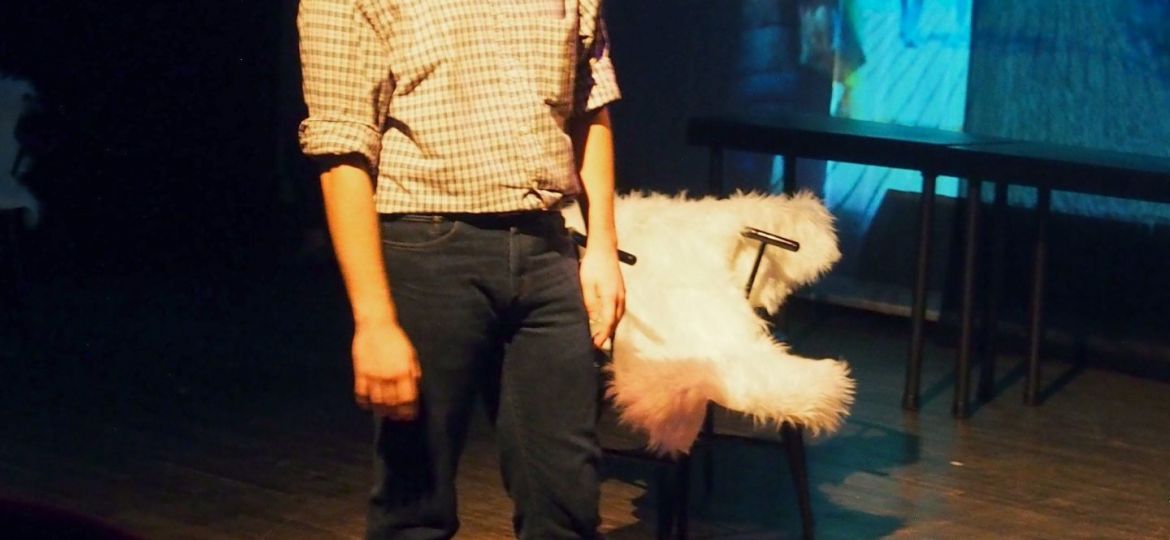
The official St. Olaf Theater Department season began last weekend with a production of “Be Here Now,” directed by Dr. Karen Peterson Wilson in Haugen Theater. Supposedly based on Anton Chekhov’s “Three Sisters,” the story indeed revolves around three sisters orphaned after their parents’ deaths. At first, the sisters are all in various stages of dissatisfaction with their love lives, which seems to be the focus of the show. The oldest sister, Olivia (Jacqueline Radke ’18), pines after her sister Michelle’s (Sabrina Wieczorek ’20) fiancé, Patrick (Lucas Hering ’21), and ends up dating him. Michelle, as uninterested in her fiancé as her sister is obsessed, starts a fling with a soldier named Jim (Tyler Seufert ’19), and eventually leaves Patrick. All this happens while the youngest sister Izzy (Veronica Silva ’20) moves between a never seen boyfriend to Zeke (Ch’aska Farber ’21) and travels to New Zealand and back. Opposite Chekhov’s play, “Be Here Now” ends not with the three sisters’ uncertain futures, but with hopeful futures as all the sisters happily embrace the man of their choice.
“Be Here Now” was originally commissioned in 2013 from playwright Carson Kreitzer by the Guthrie Theater in Minneapolis, and Kreitzer has been developing the play since then. During the rehearsal process, Kreitzer came to campus on at least one occasion to give a small playwriting master class. Not many of the department shows produced at St. Olaf boast the opportunity to work with a living playwright, and the experience must have been incredibly informative for those working on the production. But as for the performance I saw, I found the show lacking.
Kreitzer’s script severely disappoints. Whether a product of underdevelopment or overdevelopment, the script communicates its ideas with bland and generic neutrality. Seemingly, Kreitzer is unable to say anything about anything through her script. She didn’t develop any major themes to open a modern dialogue. Even Kreitzer’s one attempt for social commentary was unclear. The brief movement piece at the beginning of the play in which the characters walked around stage staring into their phones and bumping into each other lost its meaning in the confusion of the script.
Kreitzer’s inability to write compelling dialogue for her characters shows in her incessant use of monologues. For a script with so little to say, the monologues occur with a surprisingly high frequency. Furthermore, Kreitzer’s play moves much too quickly between scenes too short and too abstract to convey multi-dimensional characters. As a result, the characters all fall into cliched tropes and stereotypes. Additionally, though the set and projection designers do their best to evoke location, the incredibly quick motion leaves the audience feeling unsure as to time and place, creating an unfortunately abstract world.
As a result of Kreitzer’s disappointing writing, the actors got short shifted in the production. Though they put forth an admirable effort, the script gives them hardly any material to go on. They fight to imbue their one-dimensional characters with more depth, but many of the lines ended up coming out flat and uninspiring.
Only exacerbating the already fragmented and unfocused script, the transitions between scenes add too much time onto the performance. For scenes that last barely a minute, transitions should have been shorter. Instead, lights fade to black and back up with no particular urgency while a song segment fades in and out. Since, for most transitions, there are no actual scenery changes, the light fades and songs seem unneccesary and take time that should have been used to further expand the characters through whatever means possible.
Despite the script’s disappointments, the projection design showed promise. There were four screens in Haugen, one on each wall of the room. Since the stage was set up thrust-style with audiences on three quarters of the playing space, most of the screens were behind audience members, which ended up being less distracting than I expected. The projections were mainly static images with some short soundless videos divided between them, which were occasionally effective. I appreciated the video of a train speeding through a green countryside supporting a monologue in which a character daydreams about such a situation. Additionally, when Silva’s character in the play goes on her surprise trip to New Zealand and finds herself on the beach with a beach projection. I found the sunshine and blue light pouring over my shoulder effective as indicative of location. For one of the last scenes with Silva’s characters, in which she practices a native New Zealand art known as Poi, one of the screens displayed live capture video. Though I was unsure of the idea being communicated, it was an impressive advance in screen projection at St. Olaf.
However, the screen projection fell flat in its use of supporting images. During many of the monologues, the screens simply parroted back ideas or images that the characters mentioned. For example, when a character mentioned that they felt something was missing, the screen behind them simply displayed a stock picture of a puzzle with one piece removed. Or again when the same character mentioned their grandmother’s hands, an image of older hands appeared behind them. This use of projection sells itself short. Lighting and sound design ideally introduce some creative license of their own apart from their base requirement of reinforcing the performance, and projection possesses the same potential.
Overall the show, while boldly attempting to fit the script onto real bodies in a real space, failed to do so not entirely on its own merits, but rather those of the play. Often in a playwright’s career drafts are produced that never see continual performance not because of the playwright’s inability but simply because certain ideas either ferment too long or end up solidifying into something less compelling than intended. In this case, it is worth serious consideration whether “Be Here Now” fits into this category.

